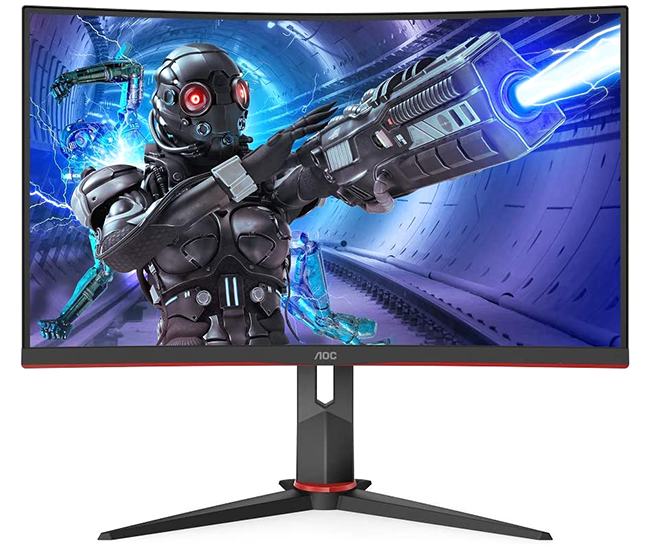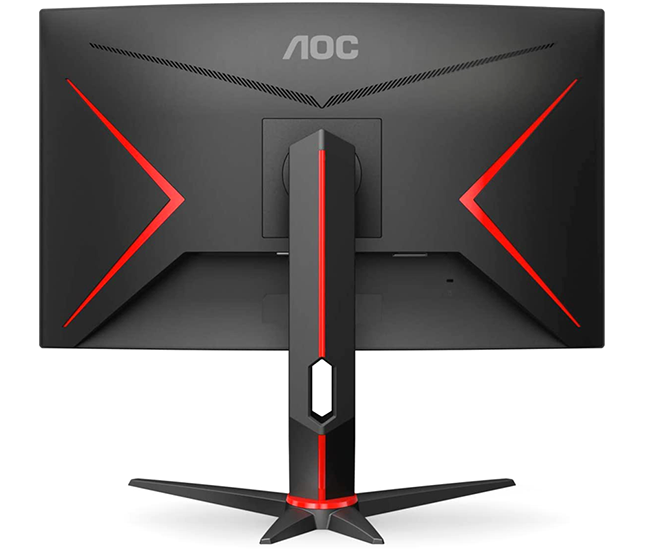Introduction
Gaming monitors are very much a case of personal preference. Some savour the extra eye candy of a 4K resolution, others take a liking to an ultrawide aspect ratio, and there are those who are willing to forego such niceties in favour of mega-fast refresh rates.
Whichever floats your boat, it is encouraging to see that each criterion can now be met without breaking the bank. 4K panels are more affordable than ever before, we've recently seen the likes of iiyama attempt large, ultrawide 144Hz gaming at hitherto unseen price points, and today we turn our attention to one of the most affordable 240Hz solutions to date, the AOC C27G2ZU.
Priced at £299, this curved 27in panel undercuts many competitors offering speeds of 240Hz or more at this particular screen size. The first thought is that overall build quality must be sacrificed, but on the contrary, the C27G2ZU looks and feels like a sturdy piece of kit. AOC's top and side bezels are suitably slim, and though the red accents are an acquired taste, they're elegantly done and by no means distracting.
We've nothing to fault in the stand department, either. Attached to a VESA-compliant mount using a single screw, the base keeps the monitor well planted with little sign of wobble, and there's decent versatility, too. Height can be adjusted up to 130mm, the panel can swivel 30° in either direction, and you get -3.5° to +21.5° of tilt. Dimensions including stand come in at 529mm~399mm (H) x 612mm (W) x 227mm (D), making the AOC relatively compact by today's standards, though the use of an external power supply does detract from overall tidiness.
On the connectivity front, display inputs include two HDMI 2.0 and a single DisplayPort 1.2, there's a 3.5mm headphone jack, and angled toward the lower-left corner is a USB hub outfitted with four USB 3.2 Gen 1 ports. Along the bottom are a series of tactile buttons for navigating the OSD, and around back, AOC integrates a pair of 2W stereo speakers as standard, however they are very basic and the target audience will resort to an external solution or a set of headphones.
Perusing the panel specification makes it immediately clear that this is a gaming solution first and foremost. A 1,920x1,080 resolution is basic at this size - the desktop lacks the clarity of, say, a 1440p display - and though we're of the opinion a curve is better suited to ultrawide form factors, the subtle 1500R arc implemented here is barely noticeable, so don't be put off by that.
A 0.5ms MPRT response time, 300-nit brightness and 3,000:1 contrast ratio is also par for the course at this price point, and it is in the refresh department that the C27G2ZU gets interesting. The VA panel can operate at a super-smooth 240Hz that surprisingly takes some getting used to. Users making the transition from a basic 60Hz monitor may find on-screen action to be so slick that it takes on a cartoonish feel; it's almost too smooth. That feeling doesn't last long, mind, and after getting acclimatised to 240Hz, going back to 60Hz seems like a major downgrade.
Such lush speeds aren't without drawbacks, mind, as our sample exhibits signs of backlight bleed, a pesky stuck pixel that we've not been able to shift, and ghosting that is clearly evident. At the monitor's top refresh rate, even the mouse cursor takes on an unexpected purple hue when moved against a dark background. I don't consider myself overly susceptible to ghosting, yet found it difficult to ignore on the C27G2ZU. Choosing one of the available overdrive settings - weak, medium or strong - can help mask the behaviour to a certain degree, but as tends to be the case with most high-speed VA solutions, neither setting is perfect. Heck, while I appreciate the smoothness of 240Hz, I may still prefer to configure the AOC to 144Hz purely to alleviate some of the ghosting, and that sort of defeats the point.
Still, the limitations of VA technology are a known quantity, and those willing to accept the trade-off will find plenty else to like. At the top of the list is FreeSync Premium support, offering adaptive framerate synchronisation in a wide 48-240Hz range over either HDMI or DisplayPort, in addition to low-framerate compensation. The panel also works just fine with modern GeForce hardware through Nvidia's G-Sync Compatible program, and at these speeds a 1080p resolution makes sense as current-generation GPUs are able to churn out the requisite frames per second in most titles.
Tear-free, fast-paced action is the name of the game, and the C27G2ZU also does a good job of keeping black crush mostly at bay. Out-the-box colour coverage and accuracy are similarly decent, and the advantages of VA tech - inky blacks and good contrast - are very much evident. Let's run the benchmark and see exactly how the AOC stacks up.












